DISCOVER NEW HORIZONS
C/2025 A6 (Lemmon)
-
Imaging Camera QHY600
-
Total Integration 12min
L: 450sec
R: 90sec
G: 90sec
B: 90sec
DISCOVER NEW HORIZONS
L: 450sec
R: 90sec
G: 90sec
B: 90sec
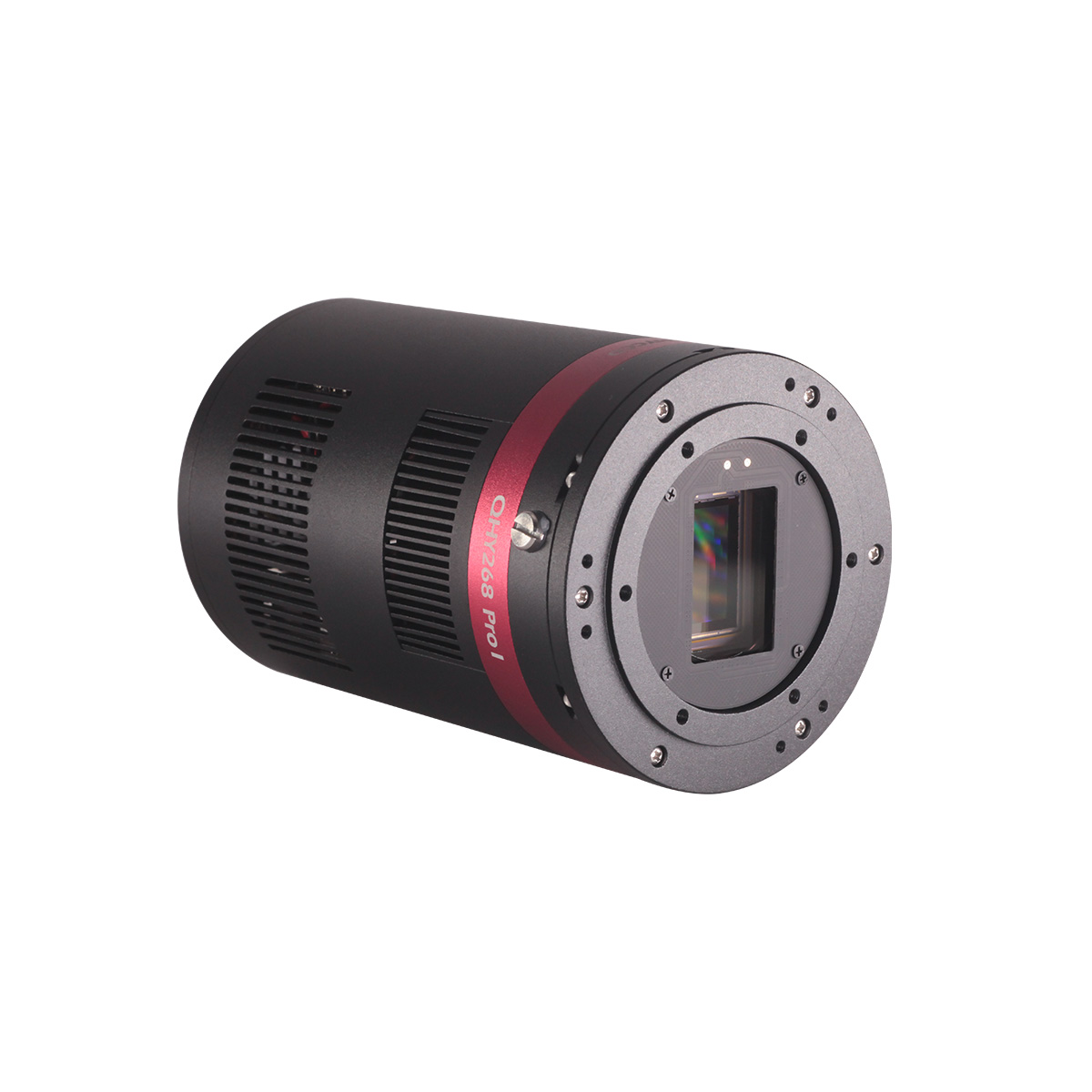

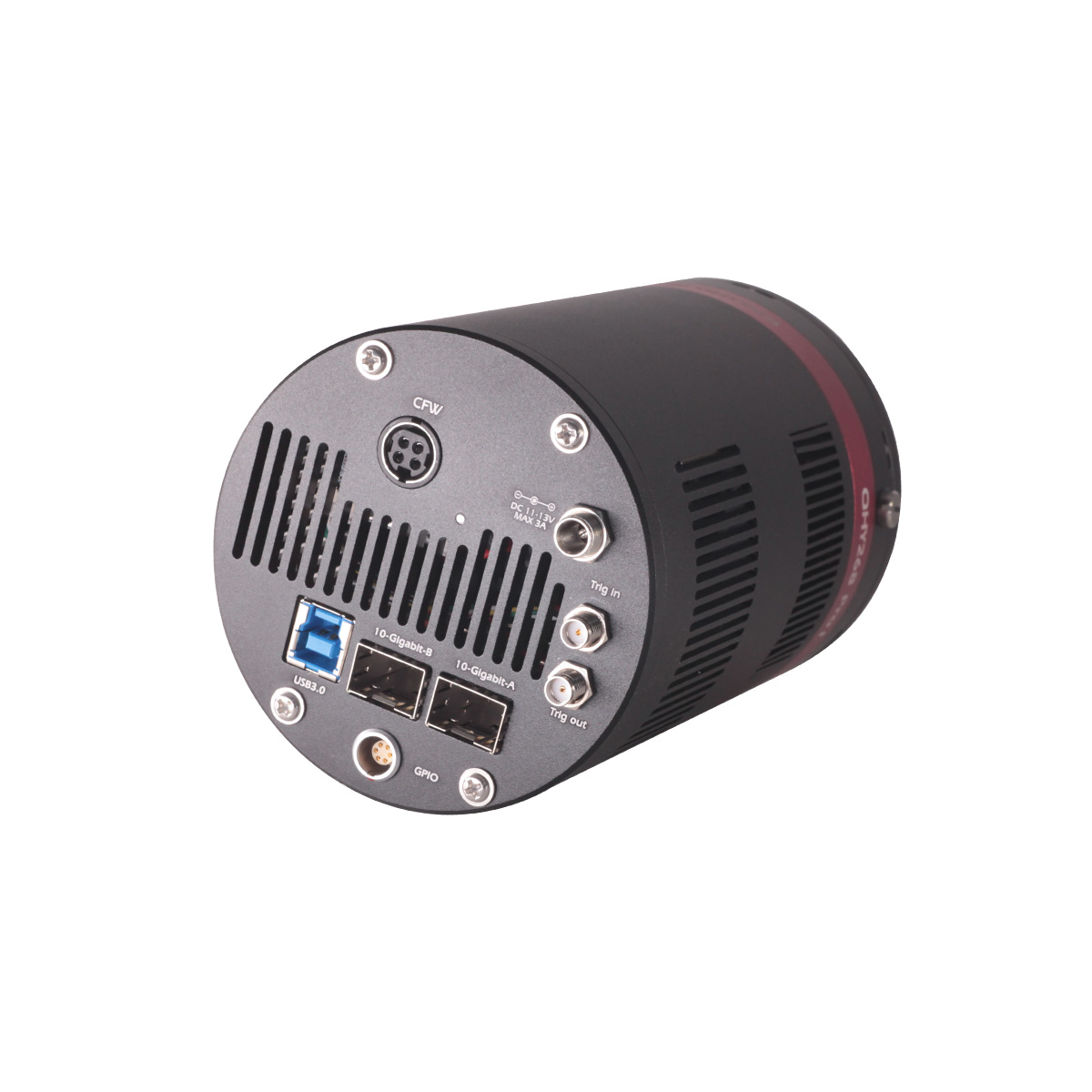
QHY268M Pro I is a scientific CMOS camera specially designed for scientific using with advanced qualities and functions.With a SONY IMX571 APS-C format CMOS sensor inside. 26mega pixels, Back-illuminated, native 16BIT ADC. QE is up to 91% and readout noise is as low as 1.1e Even with a 3.76um pixel size, it has a big full-well up to 75ke.
It has extremely low thermal noise 0.0005e/pixel/sec @ -20C, ZERO amplifier-glow performance, It has a maximum frame rate of 6.8FPS@16bit full resolution. QHYCCD IMX571.SONY IMX571/16bit/26Mpixels/BSI/APS-C Format. QHY268PRO has both USB3.0 and 2*10Gbps optical fiber interface. It has a 2GB big DDR3 memory buffer. It has the 6pin GPIO port support complex Trig-In and Trig-Out signal. It can connect with QHY GPS-BOX to get the high-precision GPS timestamp onto the image head.
Currently we only have the monochrome QHY268M Pro I as standard model. If you have requirement for color version (QHY268C Pro), please contact QHYCCD for customization.
QHY268M Pro I has SONY IMX571 APS-C format CMOS sensor inside. 26mega pixels, Back-illuminated, native 16BIT ADC. QE is up to 91% and readout noise is as low as 1.1e Even with a 3.76um pixel size, it has a big full-well up to 75ke. It has extremely low thermal noise 0.0005e/pixel/sec @ -20C, ZERO amplifier-glow performance, It has a maximum frame rate of 6.8FPS@16bit full resolution.
*PCIE Card Kit is NOT included in QHY268Pro product.
 Native 16 bit A/D: The new Sony sensor has native 16-bit A/D on-chip. The output is real 16-bits with 65536 levels. Compared to 12-bit and 14-bit A/D, a 16-bit A/D yields higher sample resolution and the system gain will be less than 1e-/ADU with no sample error noise and very low read noise.
Native 16 bit A/D: The new Sony sensor has native 16-bit A/D on-chip. The output is real 16-bits with 65536 levels. Compared to 12-bit and 14-bit A/D, a 16-bit A/D yields higher sample resolution and the system gain will be less than 1e-/ADU with no sample error noise and very low read noise.
 BSI: One benefit of the back-illuminated CMOS structure is improved full well capacity. In the back- illuminated sensor the light is allowed to enter the photosensitive surface from the reverse side. In this case the sensor’s embedded wiring structure is below the photosensitive layer. As a result, more incoming photons strike the photosensitive layer and more electrons are generated and captured in the pixel well. This ratio of photon to electron production is called quantum efficiency. The higher the quantum efficiency the more efficient the sensor is at converting photons to electrons and hence the more sensitive the sensor is to capturing an image of something dim.
BSI: One benefit of the back-illuminated CMOS structure is improved full well capacity. In the back- illuminated sensor the light is allowed to enter the photosensitive surface from the reverse side. In this case the sensor’s embedded wiring structure is below the photosensitive layer. As a result, more incoming photons strike the photosensitive layer and more electrons are generated and captured in the pixel well. This ratio of photon to electron production is called quantum efficiency. The higher the quantum efficiency the more efficient the sensor is at converting photons to electrons and hence the more sensitive the sensor is to capturing an image of something dim.
 TRUE RAW Data: In the DSLR implementation there is a RAW image output, but typically it is not completely RAW. Some evidence of noise reduction and hot pixel removal is still visible on close inspection. This can have a negative effect on the image for astronomy such as the “star eater” effect. However, QHY Cameras offer TRUE RAW IMAGE OUTPUT and produces an image comprised of the original signal only, thereby maintaining the maximum flexibility for post-acquisition astronomical image processing programs and other scientific imaging applications.
TRUE RAW Data: In the DSLR implementation there is a RAW image output, but typically it is not completely RAW. Some evidence of noise reduction and hot pixel removal is still visible on close inspection. This can have a negative effect on the image for astronomy such as the “star eater” effect. However, QHY Cameras offer TRUE RAW IMAGE OUTPUT and produces an image comprised of the original signal only, thereby maintaining the maximum flexibility for post-acquisition astronomical image processing programs and other scientific imaging applications.
 Zero Amplify Glow: This is also a zero amplifer glow camera.
Zero Amplify Glow: This is also a zero amplifer glow camera.
 Cooling & Anti-dew Control: In addition to dual stage TE cooling, QHYCCD implements proprietary technology in hardware to control the dark current noise. The optic window has built-in dew heater and the chamber is protected from internal humidity condensation. An electric heating board for the chamber window can prevent the formation of dew.
Cooling & Anti-dew Control: In addition to dual stage TE cooling, QHYCCD implements proprietary technology in hardware to control the dark current noise. The optic window has built-in dew heater and the chamber is protected from internal humidity condensation. An electric heating board for the chamber window can prevent the formation of dew.
 Sealing Technology: Based on almost 20-year cooled camera design experience, The QHY cooled camera has implemented the sealing control solutions. The sensor itself is kept dry with our silicon gel tube socket design for control of humidity within the sensor chamber. By the way, there’s no oil leaking.
Sealing Technology: Based on almost 20-year cooled camera design experience, The QHY cooled camera has implemented the sealing control solutions. The sensor itself is kept dry with our silicon gel tube socket design for control of humidity within the sensor chamber. By the way, there’s no oil leaking.
Compared to astrophotographic products, the scientific grade “Pro” grade vesion has more interfaces, more functions, and higher quality to cater for the complicated needs including but not limited to: Sky Survey, Astronomical Photometric, high-resolution LCD/OLED screen inspector/color calibration. All-sky camera. Scientific Measurement, DNA sequencer, Spectrum Instrument.
A Pro grade scientific grade camera has the following interfaces or functions.
 The built-in 2*10Gbps fiber socketcan work with the QHYCCD PCIE2.0x8 data grabber card. The fiber interface is for the requirement of the professional obs. It will give the following advantages than the USB3.0 interface. Then what is the benefit of the Fiber Interface?
The built-in 2*10Gbps fiber socketcan work with the QHYCCD PCIE2.0x8 data grabber card. The fiber interface is for the requirement of the professional obs. It will give the following advantages than the USB3.0 interface. Then what is the benefit of the Fiber Interface?
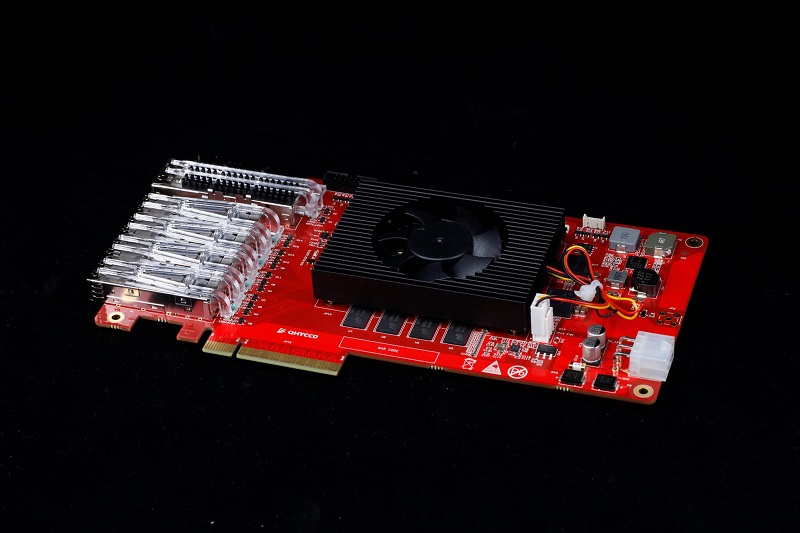
 Compared with air cooling, liquid cooling has the following important advantages. If any interst, please contact QHYCCD in advance for customization.
Compared with air cooling, liquid cooling has the following important advantages. If any interst, please contact QHYCCD in advance for customization.
No vibration. Air-cooling requires the use of a fan inside the camera that may induce small vibrations. Even the highest quality fan cannot avoid some effect on the FWHM (full width at half maximum) of stellar images on certain telescopes. Long focal length optical systems are more sensitive to this effect. However, water cooling achieves temperature reduction through the slow flow of water. There is no moving mechanical component to cause vibration of the camera, eliminating any negative effect on the image.
Multiple Readout Modes are special for QHY 16-bit Cameras (QHY600/268/461/411). Different readout modes have different driver timing, etc., and result in different performance. See details at “Multiple Readout Modes and Curves” Part.
You may find some types of thermal noise can change with time in some back-illuminated CMOS cameras. This thermal noises has the characteristic of the fixed position of typical thermal noise, but the value is not related to the exposure time. Instead, each frame appears to have its own characteristics. The QHY600/268/461/411 use an innovative suppression technology that can significantly reduce the apparent level of such noise.
UVLO(Under Voltage Locking) is to protect the electronic device from damage caused by abnormally low voltages.
Our daily life experience tells us that the actual operational voltage of an electrical device must not significantly exceed the rated voltage, otherwise it will be damaged. For such precision equipment as cameras, long-term work at too low input voltage can also be detrimental to the working life of the camera, and may even make some devices, such as power manager, burn up due to long-term overload. In the all-in-one driver and SDK after 2021.10.23 stable version, the camera will give a warning when the input voltage of the camera is below 11V.
It is common behavior for a CMOS sensor to contain some horizontal banding. Normally, random horizontal banding can be removed with multiple frame stacking so it does not affect the final image. However, periodic horizontal banding is not removed with stacking so it may appear in the final image. By adjust the USB traffic in Single Frame mode or Live Frame mode, you can adjust the frequency of the CMOS sensor driver and it can optimize the horizontal banding appeared on the image. This optimized is very effective to remove the periodic banding in some conditions.
A typical Periodic Horizontal Noise under certain USB_TRAFFIC values.
After Adjusting the USB Traffic to avoid the periodic horizontal noise.
The camera is designed to use the +12V to reboot the camera without disconnecting and reconnecting the USB interface. This means that you can reboot the camera simply by shutting down the +12V and then powering it back on. This feature is very handy for remote controlling the camera in an observatory. You can use a remotely controlled power supply to reboot the camera. There is no need to consider how to reconnect the USB in the case of remote control.
Monochrom’s Spectrum Response Curve. The curve is based on SONY’s datasheet. In the datasheet, it is the normalized curve QHYCCD test it by comparing with an known QE CCD sensor. And get this curve. This curve is only a reference. QHYCCD does not guarantee this curve is correct.
Multiple Readout Modes are special for QHY 16-bit Cameras (QHY600/268/461/411). Different readout modes result in different performance. These readout modes are currently supported in the ASCOM, SharpCap and N.I.N.A.
Photographic DSO Mode (Mode #0)
This mode is suitable for most DSO imaging situations. Since there is a drop in the noise between Gain 25 and Gain 26 (unity gain), we recommend it as default gain setting; however, gain0 is also good enough for a 16-bit sensor.
High Gain Mode (Mode #1)
This mode is something like double native iso of some new digital cameras, whose danamic range can greatly incerase at the vary high iso value, like iso800, iso3200, etc. The high gain mode provide such improvement for QHYCCD 16bit cameras. We recommend you choose this mode when you have to capture at high gain, for example, a vary dark object. Please note the switch point of HGC/LGC of QHY600/268/461 is 56. That means you must set Gain 56 to make the best of it.
Extended Fullwell Mode (Mode#2)
With a pixel size of 3.76um, these sensors already have an impressive full well capacity of 51ke. Nevertheless, QHYCCD has implemented a unique approach to achieve a full well capacity higher than 51ke- through innovative user controllable read mode settings. In Extended Fullwell Mode, the QHY600 can achieve an extremely large full-well charge value of nearly 80ke- and the QHY268 can achieve nearly 75ke-. Greater full-well capacity provides greater dynamic range and large variations in magnitude of brightness are less likely to saturate.
2CMS Modes
Extended Fullwell Mode-2CMS (Mode#3)
Photographic DSO Mode-2CMS (Mode#4)
High Gain Mode-2CMS (Mode#5)
Based on the three basic modes above, 2CMS mode can greatly reduce readout noise by secondary sampling while keeping the same full well value and system gain. We prefer 2CMS modes than basic modes in astrophotography. By the way, the recommend gain values are the same as their basic modes.
| Model | QHY268M Pro I |
| Image Sensor | Sony IMX571 |
| Sensor Type | Mono Only |
| FSI/BSI | BSI |
| Pixel Size | 3.76μm*3.76μm |
| Effective Pixels | 26 Megapixels |
| Effective Image Area | Typical APS-C |
| Effective Pixel Area | 6252*4176 |
| Total Pixel Area | 6280*4210 (include optical black area and overscan area) |
| A/D | Native 16-bit (0-65535 greyscale) A/D |
| Full Well Capacity (1×1, 2×2, 3×3)
|
Standard Mode
51ke- Extended Full Well Mode >75ke- |
| Read Noise | 1.1e- to 3.5e-
(5.3e- to 7.4e- in Extended Full Well Mode) |
| Dark Current | 0.0005 e-/pixel/sec @-20℃,
0.001 e-/pixel/sec @-10℃ |
| Exposure Time Range | 30μs-3600sec |
| Shutter Type | Electronic Rolling Shutter |
| Computer Interface | USB3.0
2*10Gigabit Fiber |
| Filter Wheel Interface
|
4PIN QHYCCD CFW Port |
| Trigger Port | Programmable TrigOut, High Speed Sync Port / GPS interface Port |
| Full Frame Rates | USB3.0:
6.7FPS@8bit 6.5FPS@16bit
12bit High Speed Mode: 14.5FPS@8bit 6.5FPS@16bit
PCIE Mode: 6.7FPS@8bit 6.7FPS@16bit |
| ROI Frame Rates
|
USB3.0:
2048lines,13.6FPS@8bit, 12.7FPS@16bit 1080lines, 25.4FPS@8bit, 21.8FPS@16bit 768lines, 35.5FPS@8bit, 28.3FPS@16bit 480lines, 52.9FPS@8bit, 39.6FPS@16bit
12bit High Speed Mode: 2048lines, 29.1FPS@8bit, 12.7FPS@16bit 1080lines, 52.5FPS@8bit, 21.8FPS@16bit 768lines, 73.2FPS@8bit, 28.3FPS@16bit 480lines, 110FPS@8bit, 39.6FPS@16bit
PCIE Mode: 2048lines, 14.0FPS@8bit 14.0FPS@16bit 1080lines, 25.4FPS@8bit 25.4FPS@16bit 768lines, 35.5FPS@8bit, 34.6FPS@16bit 480lines, 52.9FPS@8bit, 52.9FPS@16bit |
| Built-in Image Buffer | 2GB DDR3 Memory Buffer |
| Air Cooling System | Dual Stage TEC cooler:
– Long exposures (> 1 second) Typically -35℃ below ambient – Short exposure (< 1second) high FPS, Typically -30℃ below ambient(Test temperature +20℃) |
| Liquid Cooling | Available Only in LQ Version.
-45℃ below ambient with water cooling; more deltaT below ambient with cold liquid. |
| Recommended Flow Rates | 1.6ml/s |
| Anti-Dew Heater | Available |
| Humidity Sensor | Available |
| Firmware/FPGA remote Upgrade | Available via Camera USB port |
| Optic Window Type | AR+AR High Quality Multi-Layer Anti-Reflection Coating |
| Back Focal Length | 14.5mm |
| Adapters | Support 2-inch, M54, M48, Nikon/Canon DSLR Lens, etc. (Combined with adapters) |
| Weight | About 1kg |
| Power | 40W/100%
20W/50% 13.8W/0% |
The camera requires an input voltage between 11V and 13.8V. If the input voltage is too low the camera will stop functioning or it may reboot when the TEC power percent is high, causing a drain on the power. Therefore, please make sure the input voltage arrived to the camera is adequate. 12V is the best but please note that a 12V cable that is very long or a cable with small conductor wire may exhibit enough resistance to cause a voltage drop between the power supply and the camera. The formular is: V(drop) = I * R (cable). It is advised that a very long 12V power cable not be used. It is better to place the 12V AC adapter closer to the camera.
First connect the 12V power supply, then connect the camera to your computer via the USB3.0 cable. Make sure the camera is plugged in before connecting the camera to the computer, otherwise the camera will not be recognized. When you connect the camera for the first time, the system discovers the new device and looks for drivers for it. You can skip the online search step by clicking “Skip obtaining the driver software from Windows Update” and the computer will automatically find the driver locally and install it. If we take the 5IIISeries driver as an example (shown below), after the driver software is successfully installed, you will see QHY5IIISeries_IO in the device manager.
Please note that the input voltage cannot be lower than 11.5v, otherwise the device will be unable to work normally.
All-in-one Pack supports most QHYCCD models only except PoleMaster and several discontinued CCD cameras.
Download Page: https://www.qhyccd.com/download/
Video Tutorial: https://www.youtube.com/embed/mZDxIK0GZRc?start=1
Before using software, make sure you have connected the cooling camera to the 12V power supply and connected it to the computer with a USB3.0 data cable. If it’s an uncooled camera, 12V power is not needed. We recommend 64-bit Software, like SharpCAP x64 , N.I.N.A x64. etc., especially when you’re using 16bit cameras.
In NINA, you can select the device to connect to QHY Camera directly without ASCOM driver.
If connecting to the camera via ASCOM is desired, first make sure you have installed both the QHYCCD ASCOM Drivers and ASCOM Platform. Then you would select the appropriate camera driver under the ASCOM section. Then click the Connect icon. Here we take NINA as an example, but it’s similar to other software packages supporting ASCOM, like MaxDL, The SkyX, etc.
Launch SharpCap. If the software and drivers mentioned above are installed successfully, the video image will appear automatically about 3 seconds after the software loads. You will also see the frame rate in the lower left corner of the software window as shown below.
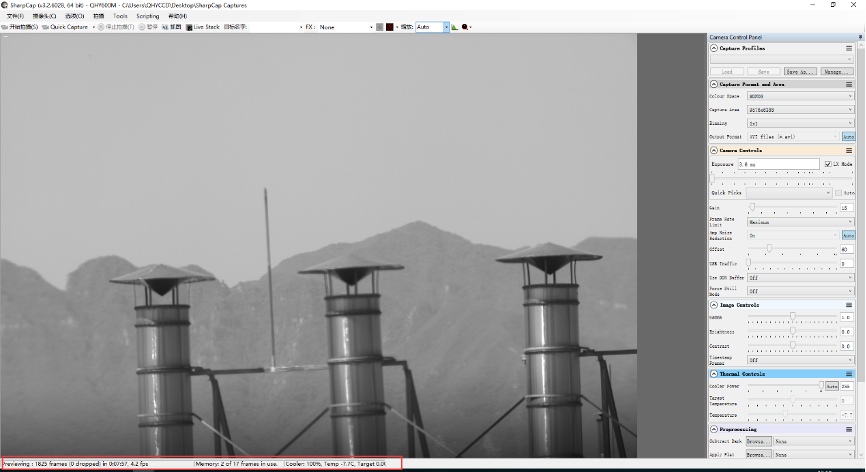
If you have already started the SharpCap software before connecting the camera, in order to open the camera, click on the “camera” in the menu bar and then select the device.
Offset adjustment. When you completely block the camera (i.e., like taking a dark frame) you may find that the image is not really zero. Sometimes this will reduce the quality of the image contrast. You can get a better dark field by adjusting the offset. You can confirm this by opening the histogram as indicated in the figure below.
If you want to enter the 16-bit image mode, select the “RAW16” mode.
By selecting the “LX” mode you can expand the exposure setting range and take long exposures.
After cooling devices connected to the 12V power supply, the temperature control circuit will be activated. You can control the CMOS temperature by adjusting the settings in the figure below. Basically, you can control the temperature of CMOS by either adjusting “Cooler Power” or clicking “Auto” and setting “Target Temperature”. You can also see the CMOS temperature at the lower-left corner of the software window.
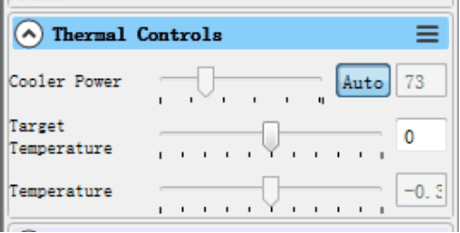
| mode 0 | mode 1 | mode 2 | mode 3 | mode 4 | mode5 | mode6 |
| GPIO1 | GPSBOX_Control | ShutterMessure+ | ShutterMessure+ | n.a | n.a | ShutterMessure+ |
| GPIO2 | GPSBOX_Data (IN) | TrigIn2 | ShutterMessure- | n.a | n.a | TrigIn2 |
| GPIO3 | GPSBOX_ShutterMessure | LinePeriod | n.a | HSYNC(OUT) | HSYNC(IN) | LinePeriod |
| GPIO4 | GPSBOX_CLK | TrigOut | n.a | VSYNC(OUT) | VSYNC(IN) | LED(OUTPUT) |
| GND | GND | GND | GND | GND | GND | GND |
UVLO(Under Voltage Locking), is primarily intended to protect the electronic device from damage caused by abnormally low voltages. Now only QHY600, QHY268, QHY410, QHY411, QHY461, QHY533 cameras have UVLO Protection.
UVLO warning execution
After a warning is given, the camera firmware will automatically turn off the cooler and will turn on the camera’s TEC protection mode. After the camera is reconnected, it will always work in TEC protection mode (maximum power cooler power will be limited to 70%). Since many times the voltage shortage is caused by the high resistance of the power supply cable itself, resulting in a large voltage drop at high currents, the voltage will usually rise after the power is limited. But limiting the power will affect the cooling temperature difference. Therefore, it is recommended that users first check the power supply cable to solve the problem of excessive resistance of the power supply cable.
If the user has solved the problem of insufficient supply voltage, the TEC protection mode can be removed through the menu of EZCAP_QT.
How to improve the power supply?
How to clear the TEC protection status triggered by UVLO?
Once a UVLO event occurs, the camera will automatically memorize it and will work in a protected mode at a maximum of 70% power after reconnection. This memory can be erased as follows:
After you find the system error, you need to turn off the device and check the power supply. After inspecting the problem, open the ezcap software and select “Camera Settings” – “Preferences” – “Reset Flash Code” to reset the error status.
Why does the warning appear even though the power supply voltage is 12 V?
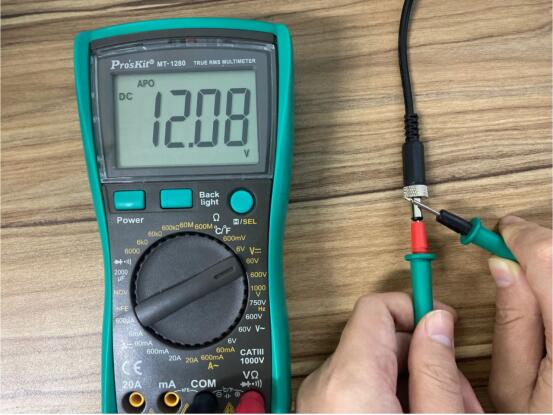
Added functions related to BURST mode in SDK. Currently, cameras that support Burst function include QHY600, QHY411, QHY461, QHY268, QHY6060, QHY4040, QHY4040PRO, QHY2020, QHY42PRO, QHY183A
This mode is a sub-mode of continuous mode. This function can only be used in continuous mode. When this function is enabled, the camera will stop outputting image data, and the software frame rate will be reduced to 0. At this time, send relevant commands to the camera, and the camera will Output the image data with the specified frame number according to the settings, for example, set Start End to 1 6, the camera will output the image data with the frame number 2 3 4 5 when receiving the command.
Note:
1. When using Burst mode in fiber mode, the first Burst shot will be one less. For example, if the start end is set to 1 6, the output of 2 3 4 5 is normal, but in fact, only 3 4 will be output during the first burst shot. 5, 2 will not be received, the second and subsequent shots can normally obtain Burst images 2 3 4 5. This problem will be fixed later.
2. QHY2020, QHY4040 found that the frame number that came out when the exposure time was short is [start+1,end-1] but the one that came out under long exposure was [start+2,end]
3. When the camera is just connected, if the set end value is relatively large, the camera will directly output the picture after entering the burst mode. Therefore, it is necessary to set the camera to enter the IDLE state and then set the start end and related burst operations.
The following is the usage of Burst mode related functions:
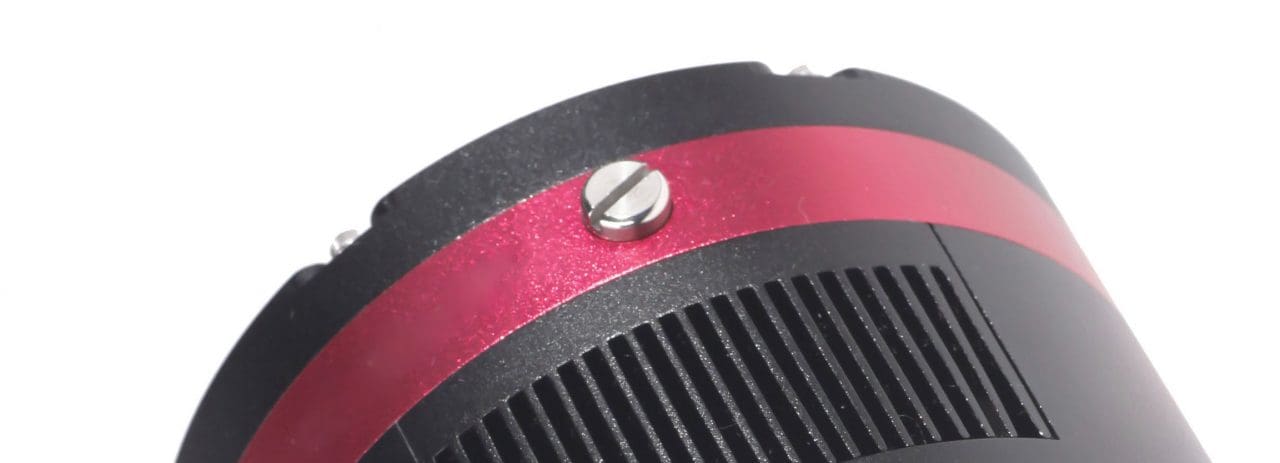 Please note that you may need to prepare desiccants yourself, because for most countries and regions desiccants are prohibited by air transport. Since QHY always deliver your goods by air, sorry that we can’t provide desiccants for you directly.
Please note that you may need to prepare desiccants yourself, because for most countries and regions desiccants are prohibited by air transport. Since QHY always deliver your goods by air, sorry that we can’t provide desiccants for you directly.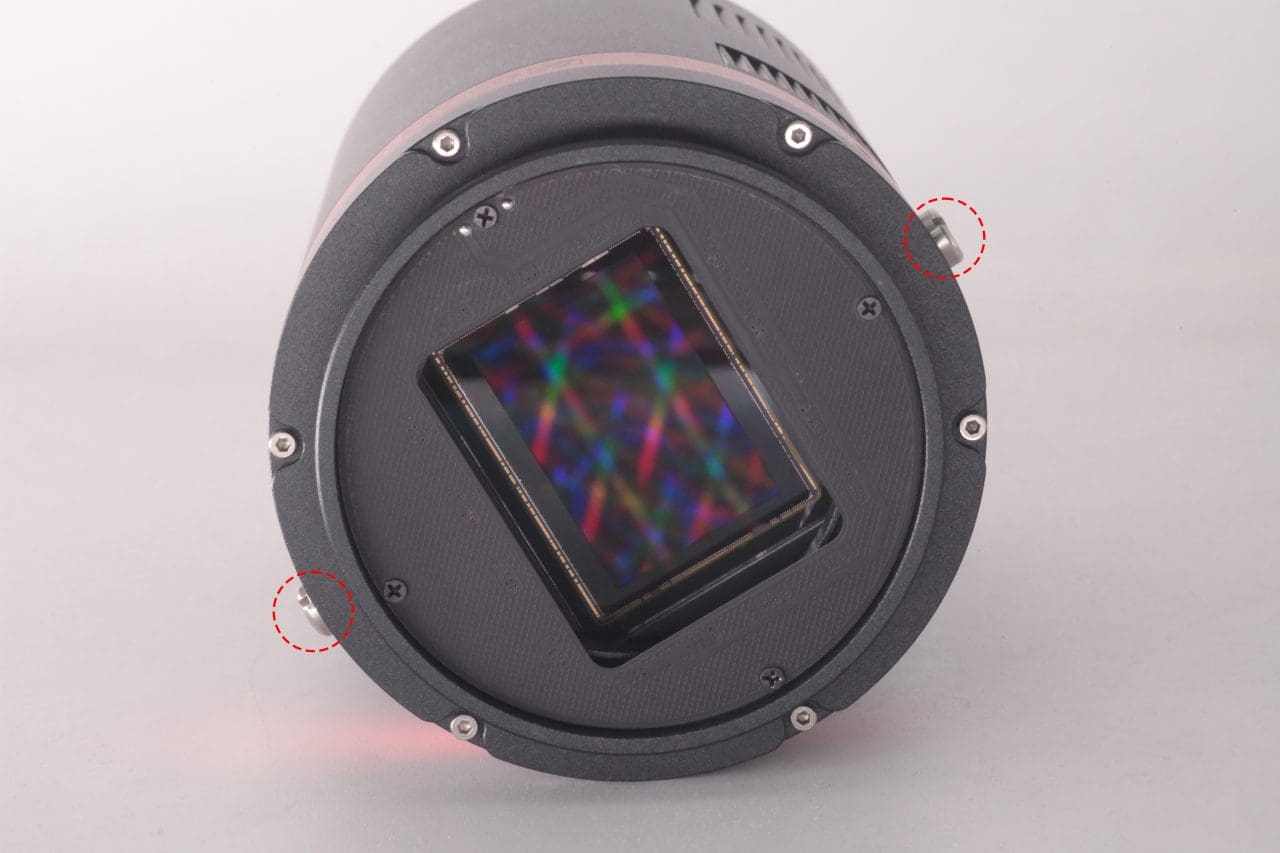
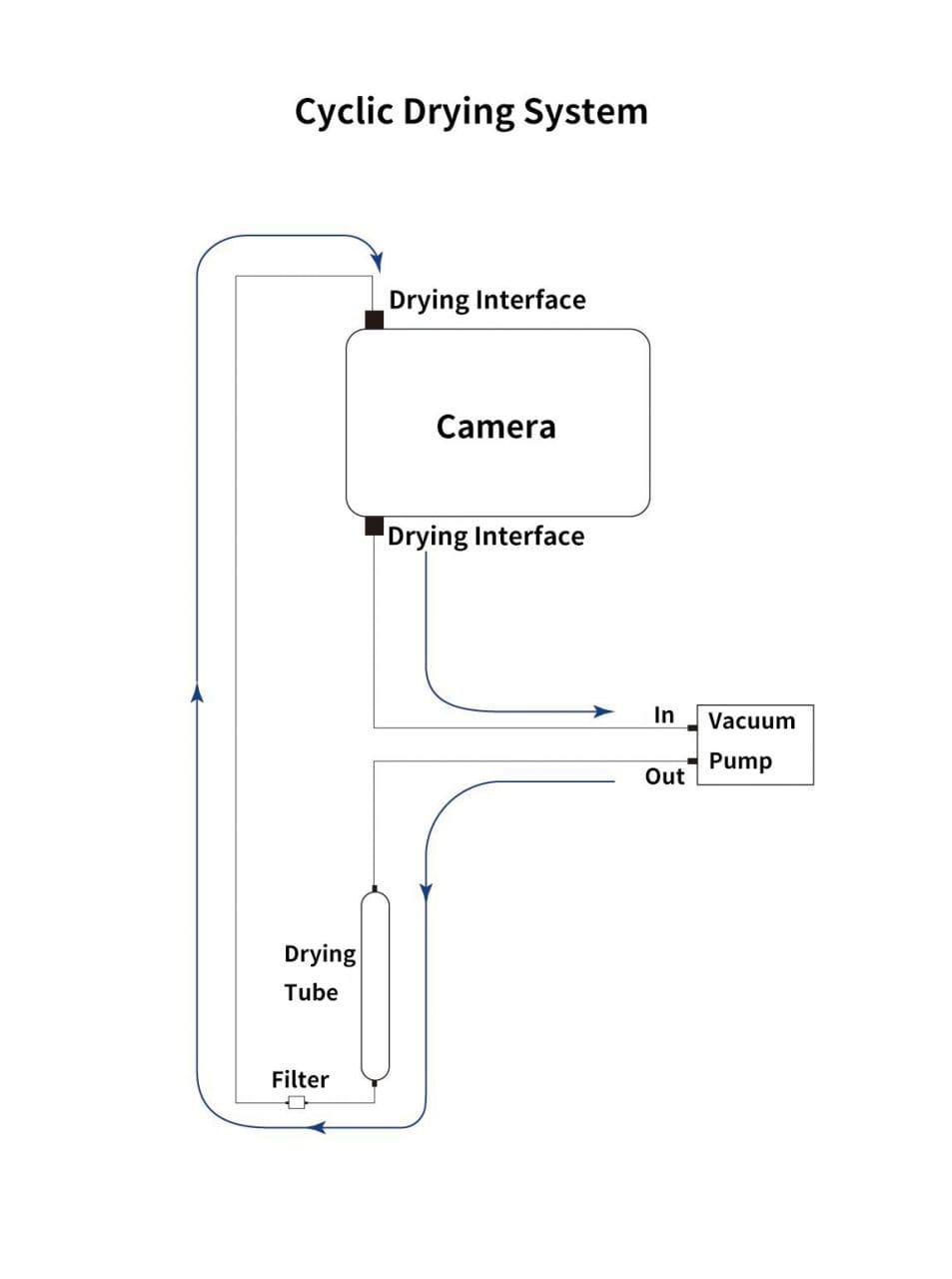 Under the vacuum pump, the gas inside the sensor chamber is drawn out through one drying interface, enters the drying tube, and then undergoes filtration. It is then reintroduced into the camera through the other drying interface, circulating back and forth for drying.
Under the vacuum pump, the gas inside the sensor chamber is drawn out through one drying interface, enters the drying tube, and then undergoes filtration. It is then reintroduced into the camera through the other drying interface, circulating back and forth for drying.
Note:1.Do not reverse the order of the intake and exhaust ports
2.Before circulating drying, it is necessary to turn off the refrigerator, and then turn on circulating drying after the temperature returns to normal temperature. Only by following this step can the water vapor in the sealed chamber be effectively removed. If the cooler is turned on, the cooler inside the camera will absorb water vapor, causing more water vapor to condense inside the camera instead of being absorbed by the desiccant.
If you find dust on the CMOS sensor, you can first unscrew the front plate of the cam and then clean the CMOS sensor with a cleaning kit for SLR camera sensors. Because the CMOS sensor has an AR (or AR/IR) coating, you need to be careful when cleaning. This coating can scratch easily so you should not use excessive force when cleaning dust from its surface.
All QHY cooling cameras have built-in heating plates to prevent fogging. However, If the ambient humidity is very high, the optical window of the CMOS chamber may have condensation issues. Then try the following:
1. Avoid directing the camera towards the ground. The density of cold air is greater than of hot air. If the camera is facing down, cold air will be more accessible to the glass, causing it to cool down and fog.
2. Slightly increase the temperature of the CMOS sensor .
3. Check if the heating plate is normally working. If the heating plate is not working, the glass will be very easy to fog, the temperature of the heating plate can reach 65-70 °C in the environment of 25 °C. If it does not reach this, the heating plate may be damaged. Please contact us for maintenance.
Please avoid thermal shock during use. Thermal shock refers to the internal stress that the TE cooler has to withstand due to the thermal expansion and contraction when the temperature of the TEC suddenly rises or falls. Thermal shock may shorten the life of the TEC or even damage it.
Therefore, when you start using the TEC to adjust the CMOS temperature, you should gradually increase the TEC power rather than turning the TEC to maximum power. If the power of the TEC is high before disconnecting the power supply, you should also gradually reduce the power of the TEC and then disconnect the power supply.
https://www.qhyccd.com/testing-the-qhy-268-mono-for-science-observations/